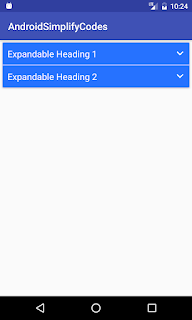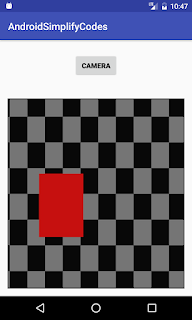Android RecyclerView is more advanced version of ListView with improved performance and other benefits. In this tutorial we are going to learn how to render a simple RecyclerView with a custom layout. We’ll also learn writing a adapter class and row click listener.
Open build.gradle and add recycler view and card view dependency. Then after rebuild the project.
build.gradle
dependencies {
compile fileTree(include: ['*.jar'], dir: 'libs')
compile 'com.android.support:appcompat-v7:25.0.1'
compile 'com.android.support:design:25.0.1'
compile 'com.android.support:cardview-v7:25.0.1'
compile 'com.android.support:recyclerview-v7:25.0.1'
}
Open res->values->styles.xml and added this below card view style into your styles file.
styles.xml
<resources>
<style name="AppTheme" parent="Theme.AppCompat.Light.DarkActionBar">
<item name="colorPrimary">@color/colorPrimary</item>
<item name="colorPrimaryDark">@color/colorPrimaryDark</item>
<item name="colorAccent">@color/colorAccent</item>
</style>
<style name="CardViewDefault" parent="CardView">
<item name="cardElevation">3dp</item>
<item name="contentPadding">5dp</item>
<item name="android:layout_width">match_parent</item>
<item name="android:layout_height">wrap_content</item>
<item name="android:layout_marginTop">5dp</item>
<item name="android:layout_marginLeft">5dp</item>
<item name="android:layout_marginRight">5dp</item>
<item name="android:layout_marginBottom">5dp</item>
</style>
</resources>
Open res->layout->activity_main.xml then after added this below line of code into your activity_main.xml file. here main componet is recycler view.
activity_main.xml
<?xml version="1.0" encoding="utf-8"?>
<LinearLayout xmlns:android="http://schemas.android.com/apk/res/android"
xmlns:tools="http://schemas.android.com/tools"
android:layout_width="match_parent"
android:layout_height="match_parent"
android:orientation="vertical"
android:background="#e7e7e7"
tools:context="com.androidsimplifycodes.example.RecyclerView.RecyclerActivity">
<android.support.v7.widget.RecyclerView
android:id="@+id/rvSelectItem"
android:layout_width="match_parent"
android:layout_height="match_parent"/>
</LinearLayout>
Create an layout xml named list_item.xml with the below line of code. This layout file renders a single row in recycler view by displaying images into card view.
list_item.xml
<?xml version="1.0" encoding="utf-8"?>
<LinearLayout xmlns:android="http://schemas.android.com/apk/res/android"
android:layout_width="wrap_content"
android:layout_height="wrap_content"
android:orientation="vertical"
android:padding="10dp">
<android.support.v7.widget.CardView
style="@style/CardViewDefault">
<ImageView
android:id="@+id/ivImage"
android:layout_width="wrap_content"
android:layout_height="300dp"
android:contentDescription="@null"
android:scaleType="fitXY"
android:src="@drawable/img2" />
</android.support.v7.widget.CardView>
</LinearLayout>
RecyclerModel is class use for the data storage. For example here stored scale bitmap into this model class.
RecyclerModel.java
package com.androidsimplifycodes.example.RecyclerView;
import android.content.Context;
import android.graphics.Bitmap;
import android.graphics.BitmapFactory;
public class RecyclerModel {
private Bitmap bitmapResource;
public Bitmap getBitmapResource() {
return bitmapResource;
}
public void setGetBitmapResource(Context context, int getBitmapResource) {
this.bitmapResource = Bitmap.createScaledBitmap(
BitmapFactory.decodeResource(context.getResources(), getBitmapResource),
500,
500,
false);
}
}
RecyclerAdapter.java
package com.androidsimplifycodes.example.RecyclerView;
import android.content.Context;
import android.support.v7.widget.RecyclerView;
import android.view.LayoutInflater;
import android.view.View;
import android.view.ViewGroup;
import android.widget.ImageView;
import android.widget.Toast;
import com.androidsimplifycodes.example.R;
import java.util.ArrayList;
public class RecyclerAdapter extends RecyclerView.Adapter<RecyclerAdapter.ViewHolder> {
private Context context;
private ArrayList<RecyclerModel> list;
RecyclerAdapter(Context context, ArrayList<RecyclerModel> list) {
// give reference to the Activity context and list into the adapter
this.context = context;
this.list = list;
}
@Override
public RecyclerAdapter.ViewHolder onCreateViewHolder(ViewGroup parent, int viewType) {
return new ViewHolder(LayoutInflater.from(context).inflate(R.layout.list_item, parent, false));
}
@Override
public void onBindViewHolder(final RecyclerAdapter.ViewHolder holder, int position) {
holder.ivImage.setImageBitmap(list.get(position).getBitmapResource());
holder.ivImage.setOnClickListener(new View.OnClickListener() {
@Override
public void onClick(View view) {
// for the displaying the current item position when click.
Toast.makeText(context, String.valueOf(holder.getAdapterPosition()), Toast.LENGTH_SHORT).show();
}
});
}
@Override
public int getItemCount() {
return list.size();
}
class ViewHolder extends RecyclerView.ViewHolder {
ImageView ivImage;
ViewHolder(View itemView) {
super(itemView);
initView(itemView);
}
private void initView(View rootView) {
ivImage = (ImageView) rootView.findViewById(R.id.ivImage);
}
}
}
RecyclerActivity.java
package com.androidsimplifycodes.example.RecyclerView;
import android.os.Bundle;
import android.support.v7.app.AppCompatActivity;
import android.support.v7.widget.LinearLayoutManager;
import android.support.v7.widget.RecyclerView;
import com.androidsimplifycodes.example.R;
import java.util.ArrayList;
public class RecyclerActivity extends AppCompatActivity {
protected RecyclerView rvSelectItem;
protected ArrayList<RecyclerModel> list;
protected RecyclerModel recyclerModel;
@Override
protected void onCreate(Bundle savedInstanceState) {
super.onCreate(savedInstanceState);
super.setContentView(R.layout.activity_main);
initView();
// initialize array list
list = new ArrayList<>();
recyclerModel = new RecyclerModel();
recyclerModel.setGetBitmapResource(this, R.drawable.img2);
list.add(recyclerModel);
recyclerModel = new RecyclerModel();
recyclerModel.setGetBitmapResource(this, R.drawable.img5);
list.add(recyclerModel);
recyclerModel = new RecyclerModel();
recyclerModel.setGetBitmapResource(this, R.drawable.img4);
list.add(recyclerModel);
recyclerModel = new RecyclerModel();
recyclerModel.setGetBitmapResource(this, R.drawable.img5);
list.add(recyclerModel);
recyclerModel = new RecyclerModel();
recyclerModel.setGetBitmapResource(this, R.drawable.img2);
list.add(recyclerModel);
recyclerModel = new RecyclerModel();
recyclerModel.setGetBitmapResource(this, R.drawable.img4);
list.add(recyclerModel);
// LinearLayoutManager user for set Recycler View HORIZONTAL Or VERTICAL
// for example LinearLayoutManager.VERTICAL Or LinearLayoutManager.HORIZONTAL
LinearLayoutManager manager = new LinearLayoutManager(RecyclerActivity.this, LinearLayoutManager.HORIZONTAL, false);
rvSelectItem.setLayoutManager(manager);
// set Our RecyclerAdapter into setAdapter() method.
rvSelectItem.setAdapter(new RecyclerAdapter(this, list));
}
private void initView() {
rvSelectItem = (RecyclerView) findViewById(R.id.rvSelectItem);
}
}
Output :























